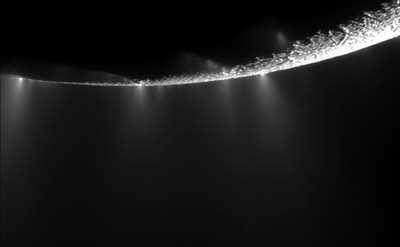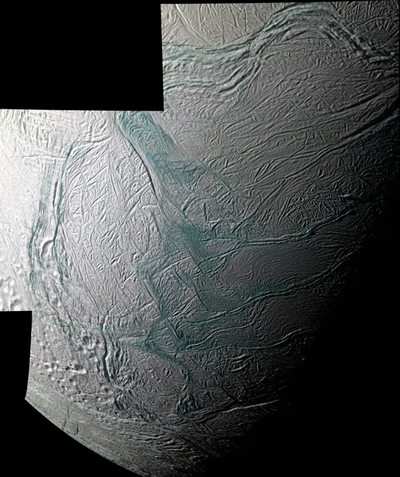Best Evidence Yet For Salt Water Reservoir Under Enceladus' Icy
Crust
NASA's Cassini spacecraft has discovered the best evidence yet
for a large-scale saltwater reservoir beneath the icy crust of
Saturn's moon Enceladus. The data came from the spacecraft's direct
analysis of salt-rich ice grains close to the jets ejected from the
moon.

Water Plumes On Enceladus
Data from Cassini's cosmic dust analyzer show the grains
expelled from fissures, known as tiger stripes, are relatively
small and usually low in salt far away from the moon. But closer to
the moon's surface, Cassini found that relatively large grains rich
with sodium and potassium dominate the plumes. The salt-rich
particles have an "ocean-like" composition and indicate that most,
if not all, of the expelled ice and water vapor comes from the
evaporation of liquid salt-water. The findings appear in this
week's issue of the journal Nature.
"There currently is no plausible way to produce a steady outflow
of salt-rich grains from solid ice across all the tiger stripes
other than salt water under Enceladus's icy surface," said Frank
Postberg, a Cassini team scientist at the University of Heidelberg,
Germany, and the lead author on the paper. When water freezes, the
salt is squeezed out, leaving pure water ice behind. If the plumes
emanated from ice, they should have very little salt in them.
The Cassini mission discovered Enceladus's water-vapor and ice
jets in 2005. In 2009, scientists working with the cosmic dust
analyzer examined some sodium salts found in ice grains of Saturn's
E ring, the outermost ring that gets its material primarily from
Enceladean jets. But the link to subsurface salt water was not
definitive.

Enceladus 2005 Image
The new paper analyzes three Enceladus flybys in 2008 and 2009
with the same instrument, focusing on the composition of freshly
ejected plume grains. The icy particles hit the detector target at
speeds between 15,000 and 39,000 mph (23,000 and 63,000 kilometers
per hour), vaporizing instantly. Electrical fields inside the
cosmic dust analyzer separated the various constituents of the
impact cloud.
The data suggest a layer of water between the moon's rocky core
and its icy mantle, possibly as deep as about 50 miles (80
kilometers) beneath the surface. As this water washes against the
rocks, it dissolves salt compounds and rises through fractures in
the overlying ice to form reserves nearer the surface. If the
outermost layer cracks open, the decrease in pressure from these
reserves to space causes a plume to shoot out. Roughly 400 pounds
(200 kilograms) of water vapor is lost every second in the plumes,
with smaller amounts being lost as ice grains. The team calculates
the water reserves must have large evaporating surfaces, or they
would freeze easily and stop the plumes.

Enceladus 2008 Image
"This finding is a crucial new piece of evidence showing that
environmental conditions favorable to the emergence of life can be
sustained on icy bodies orbiting gas giant planets," said Nicolas
Altobelli, the European Space Agency's project scientist for
Cassini.
Cassini's ultraviolet imaging spectrograph also recently
obtained complementary results that support the presence of a
subsurface ocean. A team of Cassini researchers led by Candice
Hansen of the Planetary Science Institute in Tucson, Ariz.,
measured gas shooting out of distinct jets originating in the
moon's south polar region at five to eight times the speed of
sound, several times faster than previously measured. These
observations of distinct jets, from a 2010 flyby, are consistent
with results showing a difference in composition of ice grains
close to the moon's surface and those that made it out to the E
ring. The paper was published in the June 9 issue of Geophysical
Research Letters.
"Without an orbiter like Cassini to fly close to Saturn and its
moons -- to taste salt and feel the bombardment of ice grains --
scientists would never have known how interesting these outer solar
system worlds are," said Linda Spilker, NASA's Cassini project
scientist at the Jet Propulsion Laboratory (JPL) in Pasadena,
CA.
The Cassini-Huygens mission is a cooperative project of NASA,
the European Space Agency and the Italian Space Agency. The mission
is managed by JPL for NASA's Science Mission Directorate in
Washington.
 ANN's Daily Aero-Term (04.24.24): Runway Lead-in Light System
ANN's Daily Aero-Term (04.24.24): Runway Lead-in Light System ANN's Daily Aero-Linx (04.24.24)
ANN's Daily Aero-Linx (04.24.24) Aero-FAQ: Dave Juwel's Aviation Marketing Stories -- ITBOA BNITBOB
Aero-FAQ: Dave Juwel's Aviation Marketing Stories -- ITBOA BNITBOB Classic Aero-TV: Best Seat in The House -- 'Inside' The AeroShell Aerobatic Team
Classic Aero-TV: Best Seat in The House -- 'Inside' The AeroShell Aerobatic Team Airborne Affordable Flyers 04.18.24: CarbonCub UL, Fisher, Affordable Flyer Expo
Airborne Affordable Flyers 04.18.24: CarbonCub UL, Fisher, Affordable Flyer Expo





